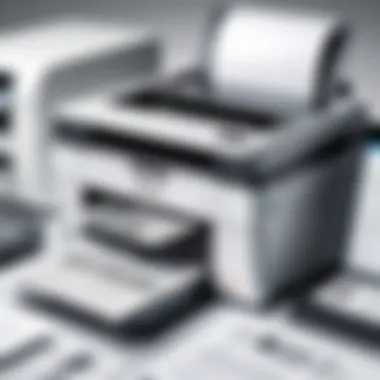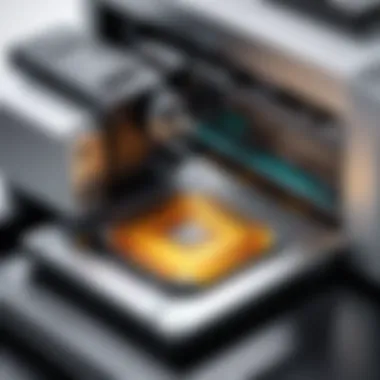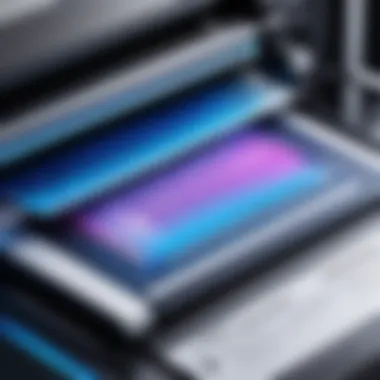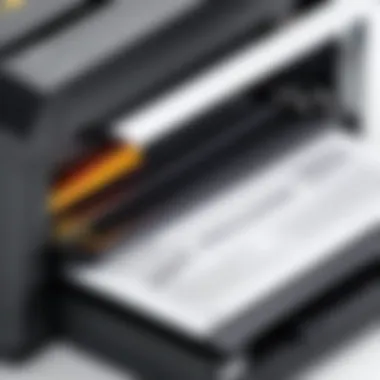The Evolution of Printer Technology: A Comprehensive Exploration of Modern Printing Solutions


Understanding Printer Technology: A Comprehensive Overview
Printers have undergone a significant transformation over the years, revolutionizing the way individuals and organizations produce physical copies of documents. From the early days of dot matrix printers to the current advanced versions such as inkjet and laser printers, the evolution of printer technology has been remarkable. This section will delve deep into the key aspects of printer technology, highlighting the progression and functionalities of different types of printers available in the market.
Inkjet Printers: Precision and Versatility
One of the most popular types of printers, inkjet printers utilize tiny droplets of ink to create images and text on paper with impressive precision. These printers are prized for their ability to produce high-quality photographs and graphics, making them ideal for both home and office use. The versatility of inkjet printers lies in their ability to print on various paper types and sizes, offering users flexibility in their printing needs.
Laser Printers: Speed and Efficiency
Laser printers are renowned for their speed and efficiency in producing text-based documents. Using a toner cartridge and a heated fuser for printing, these printers are favored in busy office environments for their rapid output. The laser technology enables crisp and clear text, making laser printers ideal for high-volume printing tasks. In this section, we will explore the inner workings of laser printers and their role in enhancing productivity.
Impact of Connectivity on Printer Technology
As technological advancements continue to shape the printing landscape, connectivity plays a pivotal role in modern printer technology. The integration of wireless printing features, cloud-based printing services, and mobile printing apps has redefined how users interact with printers. This subsection will shed light on the influence of connectivity on printer functionality and user experience.
Synthesizing Printer Innovations
In the ever-evolving realm of printer technology, innovation remains a driving force behind the development of new features and capabilities. From improved print speeds to eco-friendly printing options, manufacturers are continuously striving to enhance the user experience and reduce environmental impact. By synthesizing the innovations in printer technology, this section aims to provide readers with insights into the future direction of printing devices.
Introduction to Printer Technology
Understanding the basics of printer technology is crucial in today's digital age. Printers serve as indispensable tools for both personal and professional use, facilitating the tangible representation of digital content. This section explores the core components and mechanisms that drive these devices, shedding light on their fundamental functionality. By delving into the essence of printer technology, readers gain a profound understanding of the intricacies that underpin these ubiquitous machines.
Understanding the Basics of Printers
Key Components of a Printer
Key components of a printer encompass essential elements such as the print head, ink or toner cartridge, paper feed mechanism, and control interface. These components work synergistically to transform digital data into physical copies swiftly and accurately. The print head precisely deposits ink or toner onto the paper, ensuring clarity and precision in the printed output. The ink or toner cartridge stores the printing material, while the paper feed mechanism regulates the smooth movement of paper through the printer. The control interface serves as the command center, allowing users to customize print settings and monitor printing progress. Overall, these components form the backbone of a printer's functionality, guaranteeing efficient and reliable printing operations.
Printing Mechanisms
Printing mechanisms dictate how printers transfer digital content onto paper, with common techniques including inkjet, laser, and dot matrix printing. Inkjet printers utilize microscopic nozzles to spray liquid ink onto the paper, yielding vibrant and detailed prints. Conversely, laser printers employ laser beams to produce electrostatic images on a photosensitive drum, which are then fused onto paper using heat. Dot matrix printers create characters and images through impact-based dot matrix patterns, offering durability and versatility in industrial settings. Each printing mechanism excels in specific applications, catering to diverse printing needs with varying degrees of speed, quality, and cost-effectiveness.
Importance of Printer Technology
Printer technology plays a pivotal role in shaping modern communication and enhancing operational efficiency across various industries. By understanding the significance of printer technology, individuals and organizations can leverage these devices to streamline their workflow and optimize productivity.
Impact on Communication


The impact of printer technology on communication is profound, enabling the dissemination of information in tangible formats that transcend digital barriers. Printed documents foster engagement and comprehension, particularly in educational and marketing contexts where physical materials are preferred. By bridging the gap between digital content and physical representation, printers facilitate seamless information transfer, enriching communication channels and promoting effective knowledge sharing.
Role in Business Operations
Printers are indispensable tools in business operations, driving essential functions such as documentation, marketing collateral production, and correspondence handling. Efficient printer technology ensures timely and professional output of documents, bolstering internal communication and external engagement. In a corporate setting, printers serve as reliable assets that support administrative tasks, presentations, and regulatory compliance. By consistently delivering high-quality prints, printers contribute to enhancing the overall efficiency and efficacy of business operations.
Types of Printers
In the extensive realm of printer technology, understanding the different types of printers plays a pivotal role. Inkjet printers, laser printers, dot matrix printers, and dye-sublimation printers each offer unique features and functionality that cater to diverse printing needs. The significance of exploring these printer types lies in gaining a comprehensive insight into their operational mechanisms, advantages, and limitations, which are essential for making informed decisions when selecting a printer that aligns with specific requirements.
Inkjet Printers
Principle of Operation
Diving into the principle of operation of inkjet printers unveils a fundamental understanding of how these printers function. The key characteristic of inkjet printers is their ability to produce high-resolution prints by propelling droplets of ink onto the paper. This approach offers precise and vibrant color reproduction, making inkjet printers a popular choice for both home and office environments. The unique feature of the printhead's small nozzles ensures detailed and accurate printouts. However, one drawback is the relatively slower print speed compared to laser printers.
Advantages and Limitations
Exploring the advantages and limitations of inkjet printers uncovers their benefits and challenges in the realm of printing technology. Inkjet printers excel in producing top-notch photo prints with sharp colors and gradients, making them ideal for graphic-intensive prints. Their compact size and affordability appeal to consumers seeking a versatile printing solution. However, the cost of ink replacement cartridges and the susceptibility to smudging on plain paper are among the limitations of inkjet printers.
Laser Printers
Working Process
Understanding the working process of laser printers illuminates their efficiency in high-speed printing tasks. Laser printers utilize laser technology to produce electrostatic images on a photosensitive drum, which are then transferred and fused onto paper. This process ensures rapid and precise printing, making laser printers a preferred choice for busy office environments. The unique feature of toner cartridges in laser printers guarantees long-lasting prints with sharp text and images. Yet, the initial cost and larger size of laser printers may pose drawbacks for some users.
Benefits and Drawbacks
Delving into the benefits and drawbacks of laser printers sheds light on their advantages and challenges in the printing landscape. Laser printers deliver speedy monochrome prints, suitable for text-heavy documents and office tasks. Additionally, their ability to handle high-volume printing with consistent quality enhances productivity. On the flip side, laser printers are generally more expensive upfront, and color laser printing can be cost-prohibitive for smaller businesses.
Dot Matrix Printers
Functionality
Exploring the functionality of dot matrix printers reveals their unique operating mechanism. Dot matrix printers create characters and images by striking a grid of pins against an ink-soaked ribbon, forming patterns on paper. This method allows for carbon copies and impact printing, making dot matrix printers valuable in specific business applications. The unique feature of dot matrix printers lies in their reliability and ability to create multipart forms with ease. However, their slower speed and lower print quality compared to laser and inkjet printers may limit their widespread use.
Usage Scenarios
Analyzing the usage scenarios of dot matrix printers showcases their versatility in specialized printing tasks. Industries that require continuous form printing, such as receipts and invoices, benefit from the durability and efficiency of dot matrix printers. Moreover, their ability to work in demanding environments with minimal maintenance makes them suitable for scenarios where robustness is paramount. In contrast, the noisy operation and limited graphical capabilities are considerations when opting for dot matrix printers in modern settings.


Dye-Sublimation Printers
Print Quality
Examining the print quality aspect of dye-sublimation printers highlights their exceptional output characteristics. Dye-sublimation printers apply heat to transfer dye onto various media, resulting in vivid and durable prints with continuous tones. The key characteristic of dye-sublimation printers is their ability to produce professional-quality photographs and graphics with unparalleled color accuracy. This feature makes them preferred for applications where superior print quality is essential. Nevertheless, the cost per print and limited media compatibility are factors to consider when assessing the benefits of dye-sublimation printers.
Applications
Exploring the applications of dye-sublimation printers illustrates their diverse utility across different industries. From creating vibrant apparel designs to producing intricate product labels, dye-sublimation printers offer a versatile printing solution for various businesses. Their ability to transfer designs seamlessly onto unique substrates like ceramics and plastics broadens their applications in sectors ranging from fashion to manufacturing. However, the specialized nature of dye-sublimation printing and the requirement for specific media limit its widespread adoption in traditional office settings.
Specialty Printers
Specialty printers represent a crucial aspect of the comprehensive guide on printer technology, catering to specific niche needs and demanding applications that traditional printers may not fulfill adequately. Their significance lies in their ability to offer specialized functionalities tailored to unique requirements, enhancing efficiency and accuracy in various industries. When considering specialty printers, factors such as print quality, durability, and customization options take precedence, ensuring optimal performance for specific tasks. Industries such as healthcare, manufacturing, and retail rely heavily on specialty printers for barcode labeling, signage, and product labeling, showcasing their intrinsic value in streamlining operations and enhancing productivity.
3D Printers
Technology Overview
3D printers revolutionize the manufacturing landscape by utilizing additive manufacturing techniques to create physical objects layer by layer from digital models. This technology overview underscores the additive nature of 3D printing, enabling the production of complex shapes and structures that traditional manufacturing methods struggle to replicate. The key characteristic of 3D printers lies in their versatility and precision, offering unparalleled design freedom and customization possibilities. While 3D printing presents advantages such as rapid prototyping, cost-effectiveness, and reduced material wastage, challenges such as limited print speed and material limitations need consideration in this article.
Industry Applications
Dive deep into the industrial applications of 3D printing technology, exploring its impact across sectors such as aerospace, healthcare, automotive, and architecture. The key characteristic of 3D printers shines in their ability to create intricate prototypes, medical implants, concept models, and architectural maquettes with exceptional detail and accuracy. Industries leverage 3D printing for rapid product development, bespoke manufacturing, and innovative design solutions, showcasing its versatility and value in enhancing efficiency and competitiveness. Despite its myriad advantages, challenges like post-processing requirements and material selection complexities warrant discussion to provide a holistic view in this article.
Wide-Format Printers
Usage in Design and Engineering
Wide-format printers play a crucial role in design and engineering industries, facilitating the printing of large-scale graphics, technical drawings, and architectural plans with precision and clarity. The key characteristic of wide-format printers lies in their ability to accommodate different media sizes and substrates, catering to diverse printing requirements in design studios, construction firms, and advertising agencies. The unique feature of wide-format printers is their high-resolution output and color accuracy, essential for producing eye-catching visuals and detailed schematics. While wide-format printers offer enhanced productivity and creativity, considerations regarding maintenance costs and space requirements are pertinent in this article.
Printing Capabilities
Explore the printing capabilities of wide-format printers, delving into their speed, resolution, color capabilities, and media handling capacities. The key characteristic of wide-format printers lies in their ability to produce large-format prints with exceptional detail and vibrancy, ideal for applications such as banners, posters, and architectural renderings. Wide-format printers thrive in delivering high-quality output in quick turnaround times, catering to the demanding needs of design professionals and engineers. Despite their advantageous features, factors like initial investment, operational costs, and consumables expenses warrant attention to provide a comprehensive overview in this article.
Label Printers
Labeling Solutions
Uncover the versatility of label printers in providing efficient labeling solutions for diverse industries ranging from logistics and retail to healthcare and manufacturing. The key characteristic of label printers lies in their ability to produce customized labels swiftly, accurately, and cost-effectively, addressing labeling needs for products, shipments, and assets. Label printers' unique feature is their variable data printing capabilities, allowing for on-demand customization and serialization of labels for improved traceability and brand identification. While label printers offer significant advantages such as reduced waste, increased operational efficiency, and compliance adherence, factors like label durability, print speed, and label format compatibility merit examination in this article.


Industrial Versatility
Delve into the industrial versatility of label printers, exploring their adaptable nature in managing diverse labeling requirements across industries. The key characteristic of label printers shines in their capacity to handle varied label sizes and types, ensuring seamless integration into production lines and warehouse operations. Label printers' unique feature lies in their connectivity options, enabling integration with existing systems for automated label printing and data synchronization. While label printers enhance productivity, organization, and branding efforts, considerations around maintenance, label adhesive properties, and software compatibility need discussion to offer a comprehensive view in this article.
Choosing the Right Printer
Choosing the right printer is a critical decision with vast implications for both individuals and businesses. Selecting a printer that aligns with specific requirements can enhance productivity and efficiency in printing tasks. Factors to consider when choosing a printer include print volume, cost efficiency, and print quality. Understanding these elements is paramount to making an informed decision that meets one's needs effectively.
Factors to Consider
Print Volume
Print volume plays a pivotal role in the overall effectiveness of a printer. It refers to the number of pages a printer can produce within a specific period. Print volume considerations are crucial for users with high printing demands, such as busy offices or printing businesses. A printer with a high print volume capacity can handle substantial workloads without compromising on efficiency. However, high print volume printers often come with higher upfront costs and operational expenses.
Cost Efficiency
Cost efficiency is a key consideration for individuals and businesses alike. This aspect focuses on optimizing printing expenses while maintaining quality output. Budget-conscious users may prioritize printers with features like duplex printing, ink-saving modes, or compatible third-party cartridges to reduce operational costs. However, it's vital to balance cost efficiency with performance to ensure that savings do not compromise productivity.
Print Quality
Print quality significantly impacts the final output of printed materials. High print quality ensures clear, crisp text and vibrant images, essential for professional documents and marketing materials. Print resolution, color accuracy, and toner or ink quality are key determinants of print quality. Users requiring exceptional print quality may opt for printers with advanced DPI capabilities or specialized color management features to achieve superior results.
Matching Printer to Needs
Personal Use
Personal use printers cater to the unique requirements of individuals seeking reliable printing solutions for home or small office use. These printers emphasize user-friendly features, compact designs, and wireless connectivity for seamless printing. Printers suitable for personal use often prioritize convenience and versatility, offering options like mobile printing and cloud integration for enhanced accessibility.
Business Requirements
Business requirements dictate the choice of printers in commercial settings, where efficiency and productivity are paramount. Business-focused printers are designed to handle large print volumes, support network connectivity, and offer robust security features to safeguard sensitive data. Scalability, speed, and multifunction capabilities are essential considerations when selecting printers to meet the dynamic demands of modern workplace environments.
Future Trends in Printing Technology
In understanding the evolution of printer technology, it becomes imperative to delve into the future trends that are shaping the industry. The landscape of printing technology is constantly evolving, driven by advancements that have the potential to revolutionize traditional practices. By exploring the future trends in printing technology, we gain valuable insights into what lies ahead for the industry. This section will focus on emerging technologies and concepts that are influencing the way printers function and interact with other systems. Io T Integration is one such trend that is progressively gaining traction in the printing industry.
Advancements in Printing Industry
IoT Integration
Io T Integration refers to the incorporation of Internet of Things capabilities into printing devices, enabling seamless connectivity and enhanced functionalities. This aspect plays a vital role in streamlining printing processes and optimizing performance. The key characteristic of IoT Integration lies in its ability to facilitate remote monitoring and management of printers, promoting efficient operations and proactive maintenance. As a beneficial choice for this article, IoT Integration enhances productivity by enabling automated tasks such as supply reordering and troubleshooting. Its unique feature of real-time data monitoring empowers users to track usage patterns and identify areas for improvement. Despite its advantages in optimizing printing workflows, IoT Integration may pose challenges related to data security and privacy that need to be carefully addressed.
Green Printing Initiatives
Green Printing Initiatives underscore the industry's commitment to environmental sustainability by promoting eco-friendly printing practices. This aspect is instrumental in reducing carbon footprint and minimizing wastage in the printing process. The key characteristic of Green Printing Initiatives lies in adopting renewable resources and energy-efficient methods to minimize environmental impact. As a popular choice for this article, Green Printing Initiatives align with the increasing emphasis on corporate social responsibility and sustainable business practices. Its unique feature of promoting recycled materials and reducing emissions contributes to a greener printing ecosystem. While the advantages of Green Printing Initiatives include cost savings and enhanced brand reputation, it may entail challenges in transitioning to sustainable practices and implementing new technologies effectively.



